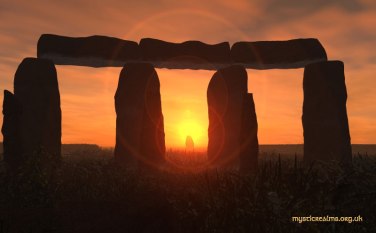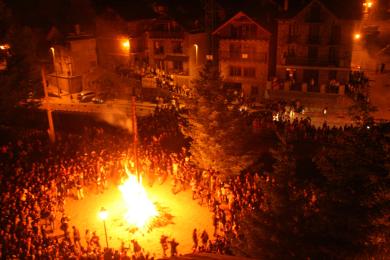Sunday, June 21st, is the summer solstice, better known as the first day of summer. It is also known as Midsummer’s Eve or the Wiccan celebration of Litha. I thought it would be interesting to share some of the ancient customs of this night.
The summer solstice is the longest day of the year in the Northern hemisphere.
If Stonehenge is anything to go by, summer celebrations have a millennia-old history. While the ancient druids may have commemorated the fertility of the season, many of us are just happy to get outdoors after a long winter. 
In a lot of cultures, the solstice marks the start of summer. In Scandinavia, where it’s known as Midsummer, it is one of the biggest holidays on the calendar. The day is celebrated with copious amounts of herring, vodka, singing, and a dance around the maypole. Throughout much of Europe, it’s referred to as St. John’s Day, and is honored with bonfires and dancing, and in some cases, a naked sprint across town.
In England, rural villagers built a big bonfire on Midsummer’s Eve. This was called “setting the watch,” and it was known that the fire would keep evil spirits out of the town. Some farmers would light a fire on their land, and people would wander about, holding torches and lanterns, from one bonfire to another. If you jumped over a bonfire — presumably without lighting your pants on fire — you were guaranteed to have good luck for the coming year.
It is believed in parts of England that if you stay up all night on Midsummer’s Eve, sitting in the middle of a stone circle, you will see the Faeries. But be careful – carry a bit of rue, also called “herb of grace”, in your pocket to keep them from harassing you, or turn your jacket inside out to confuse them. If you have to escape the Faeries, follow a ley line, and it will lead you to safety. L ey lines are old walking tracks across the countryside believed to connect a series of ancient sites such as standing stones oriented to sunrise and sunset at the solstices.
Residents of some areas of Ireland say that if you have something you wish to happen, you “give it to the pebble.” Carry a stone in your hand as you circle the Litha bonfire, and whisper your request to the stone — “heal my mother” or “help me be more courageous”, for example. After your third turn around the fire, toss the stone into the flames.
Astrologically, the sun is entering Cancer, which is a water sign. Midsummer is not only a time of fire magic, but of water as well. Now is a good time to work magic involving sacred streams and holy wells. If you visit one, be sure to go just before sunrise on Litha, and approach the water from the east, with the rising sun. Circle the well or spring three times, walking sunwise – clockwise – and then make an offering of silver coins or pins. Sunwheels were used to celebrate Midsummer in some early Pagan cultures. A wheel, or sometimes a really big ball of straw , was lit on fire and rolled down a hill into a river. The burned remnants were taken to the local temple and put on display. In Wales, it was believed that if the fire went out before the wheel hit the water, a good crop was guaranteed for the season.
, was lit on fire and rolled down a hill into a river. The burned remnants were taken to the local temple and put on display. In Wales, it was believed that if the fire went out before the wheel hit the water, a good crop was guaranteed for the season.
In Egypt, the Midsummer season was associated with the flooding of the Nile River delta. In South America, paper boats are filled with flowers, and then set on fire. They are then sailed down the river, carrying prayers to the gods. In some traditions of modern Paganism, you can get rid of problems by writing them on a piece of paper and dropping them into a moving body of water on Litha. William Shakespeare associated Midsummer with witchcraft in at least three of his plays. A Midsummer Night’s Dream, Macbeth, and The Tempest all contain references to magic on the night of the summer solstice.
Other customs included decking the house (especially over the front door) with birch, fennel, St. John’s wort, orpin rose, and white lilies. Five plants were thought to have special magical properties on this night: rue, roses, St. John’s wort, verbena and trefoil. Indeed, Midsummer’s Eve in Spain is called the ‘Night of the Verbena’. St. John’s wort was especially honored by young maidens who picked it in the hopes of divining a future lover.
No matter how you choose to celebrate the solstice, have a wonderful summer.
-
Join 5,103 other subscribers
- Follow Pink Fuzzy Slippers Authors on WordPress.com
Sharing Special News
Coming soon: SEEKING PATIENCE by Josie Riviera-
Recent Posts
- FREE Ebook with Newsletter sign-up, A Homecoming to Cherish April 7, 2024
- 1-800-IRELAND, a Heartwarming Irish Romance and only 99 cents. March 24, 2024
- FREE Sweet Romance Book: A Chocolate-Box Irish Wedding March 17, 2024
- Maeve: A Sweet Irish Romance on the Shores of Corsica (Free for a Limited Time!) March 10, 2024
- 1-800-CUPID: A Sweet Valentine’s Romance That Sparks Your Heart. February 25, 2024
- 🍫❤️ A Chocolate-Box Valentine eBook: Where Romance Meets Sweetness ❤️🍫 February 11, 2024
- A Valentine To Cherish is FREE. February 4, 2024
- New Release! Pawfect Christmas Hearts January 21, 2024
- 1-800-NEW YEAR: A Heartwarming Holiday Romance for Just 99 Cents in the US Kindle Countdown! January 21, 2024
- Where Is My Toolbox or Who Makes the Rules, anyway? January 19, 2024
Follow me on Twitter
My TweetsSchedule
Monday: Mary Marvella & Sydney Montgomery
Tuesday:
Wednesday: Guest visits with M
Thursday: Deb Julienne
Friday: Linda Nightingale and Toni Sweeney
Saturday: Beth Trissel
Sunday: Josie RivieraSocial

Great posts. It reminded me of a story I started a few years ago where a photographer set up a stone circle to try and take a picture of a fairy. Instead the fairy caused her to time travel to…well, I guess I’d better finish the story to see how it ends!
LikeLike
You’ve got me hooked! Now you have to finish the book!
LikeLike
Loved this blog, tweeted and shared it. I also wrote a story about a midsummer custom – specifically, about visiting a holy well to ask a boon of the fairies. It’s not finished either. 😉
LikeLike
Thanks Barbara, I’m glad you enjoyed the post. I love writing about magic. My latest MS is about a coven of Wiccans.
LikeLiked by 2 people
Such an interesting blog! I wasn’t aware of these customs, so thanks for sharing.
LikeLike
Reblogged this on Linda Nightingale…Wordsmith.
LikeLike
Very interesting! I reblogged, tweeted and put it on Facebook. Linda
LikeLike
Thanks Josie and Linda!
LikeLike
Reblogged this on Author M. J. Flournoy and commented:
Now I want to finish my fairy-timetravel-highlander book!
LikeLike
Pingback: Midsummer’s Eve | Author M. J. Flournoy